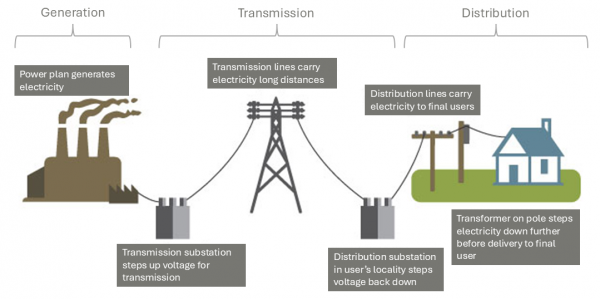Electricity Supply: A Primer
Genevieve Signoret & Delia Paredes
(Hay una versión en español de este artículo aquí.)
In conducting research on Mexico energy policy, we’ve had to teach ourselves some basic vocabulary related to electricity and Mexican energy law. So we decided to share what we’ve learned with you by putting out some primers.
This first primer lays out the three stages of electric power supply to consumers and lists some of the infrastructure it requires.
Three Stages
To be able to boot up your laptop to read Timón Económico, you’ll need a source of electric power that has gone through three stages: generation, transmission, and distribution.
The three stages of electric power supply

Source:U.S. Energy Information Agency.
Generation: The power is first generated at a power plant, in North America, usually at 13,200 volts. Plants can be fueled by coal, natural gas, nuclear energy, hydroelectric power, wind, the sun, and other renewable sources.
Transmission: From the plant, the power moves to a transformer, or substation, that steps the voltage up to at least 330,000 before sending it through high-voltage power lines connected by transmission . This minimizes the energy loss incurred during long-distance transmission.
Distribution: At a distribution substation in or near the user’s locality, the voltage is stepped back down to a safer 13,200 volts, then is carried along distribution lines to a distribution transformer and from there through lines to homes and businesses.
Notice All the Infrastructure
We’ve shown you a highly simplified schematic of what in fact is an extremely complex process. Because it’s so complex, it requires a tremendous amount of infrastructure, including (and we quote from the U.S. Department of Commerce):
power transformers, voltage regulators, circuit breakers, switchgear, capacitors, fuses, controls, arresters, conductor, as well as electric vehicle charging infrastructure and associated grid control technologies like supervisory control and data acquisition (SCADA) systems, advanced distribution management systems (ADMS), distributed energy resource management systems (DERMS), virtual power plant (VPP), cybersecurity systems and more.
And that’s just the physical infrastructure. On the service side, we have, additionally:
associated engineering, procurement, and contracting (EPC), accounting, project financing, research and development (R&D), testing and certification (T&C), and other related services.
Any discussion of electricity supply in Mexico will need to address who will supply all this infrastructure, what it will cost, and how it will be funded.
TransEconomics delivers serenity to high net worth families and individuals. To learn more, request an appointment with an advisor.

